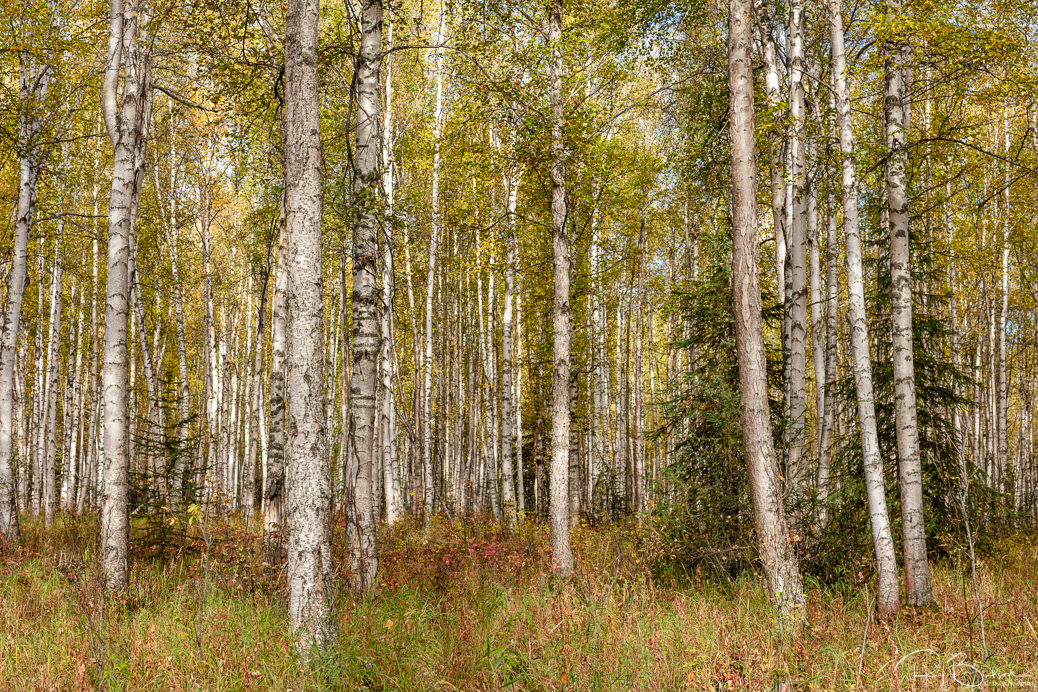
Birch tree forest (35 mm, f/16, 1/10 sec.)
What makes some photos more visually appealing than others? As landscape photographers we are blessed – and sometimes overwhelmed – with a variety of compositional tools, many borrowed from painters. The rule of thirds, power shapes, the psychology of colors, simplifying, abstraction and placement of the horizon line are just a few. However, tools are foundational to a larger goal of most photographers which is to convey how they felt when they captured the moment, perhaps to tell a story, evoke an emotion, or compel an action. For landscapes especially, if the viewer feels they can walk into the frame and have a sense of “being there,” the photographer’s intentions become stronger and more effective.
As I write this in Southcentral Alaska we are nearing the end of autumn. Fall foliage colors usually peak mid-September as colder temperatures and shorter days abruptly end our frenetic, light drenched, summer. Fortunately we have had some unseasonably warm weather to stretch out our enjoyment of the outdoors. Last week I ventured out on a 60-degree day. The blue sky was filled with mostly high cirrus clouds providing great, soft light, and the air was heavily perfumed with the smell of ripe high-bush cranberries. [It’s a particular odor that my wife and I likened to a wet, dirty dog smell when we first moved here twelve years ago as cheechakos (Alaskan for tenderfoot).] It felt great to be outside and as I searched for a photo to remember the day I came upon this expansive birch forest. I took many photos but ended up processing the two shown here. Both capture the day but the one above is more appealing and truer to how I felt. Why is that?

Alternative rendition of birch tree forest (50 mm, f/8, 1/50 sec.).
Because the camera lens sees differently than our eyes, lens selection was important to record the perspective I saw in the field. The angle of view of the human eye is 55 degrees which corresponds to a lens focal length of 43 degrees. I have read many discussions with various optical definitions which argue if you want to duplicate our visual perception use lenses from 35 to 50 mm. The first photo was taken at 35 mm and the second at 50 mm. I do feel that I could walk into both photos, but the second one lacks the depth of the first. The difference, I believe, is due to lighting and negative space.
Lighting in the second photo was almost directly behind me and more diffuse. Almost no shadowing is present. The resulting flat appearance is typical of front-lighting. The lighting in the first photo, however, was approximately 45 degrees behind me and to my right. It was brighter and produced shadows of the foreground trees. This contrast and directional lighting produced a sense of depth and dimensionality lacking in the second photo. The diagonal lines of the shadows also break up the strong vertical lines of the tree trunks which adds a dynamic component to the image.
Availability of more negative space in the first photo also contributed to more depth. Because there was more room for me to walk among the birch trees the eye has more freedom to explore. Also, use of the 35 mm lens expanded the foreground to background perspective. In the second photo there is less foreground room and the background seems closer and closed due to the apparent density, or crowding, of the trees. The 50 mm lens used in the second photo compressed foreground and background more than the 35 mm lens squeezing out space for the eye to roam.
Two photos taken within minutes of each other with slightly different focal length lenses and different lighting resulted in different expressions of the birch forest. In the preface to Freeman Patterson’s classic, Photography and The Art of Seeing, Patterson wrote “The art of seeing is the art of photography.” By understanding how to reconcile what a camera sees with what our eyes see and the varying qualities of light, we can better convey the experiential content and art of our photography. In this case, I believe it more effectively allows others to walk with me on that beautiful fall day.


